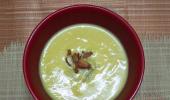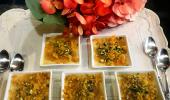
Vidhya Joshi moved to Shillong in 1967 after marriage, when she was 16½ years, becoming Vidhya Pant. Her husband had a prosperous grocery-pharmacy business over there, that had been established by Vidhya's father-in-law, after he gave up working with the Indian army canteen.
They lived in a large home, located within a compound, in the town.
Vidhya remembers her first few post-marriage Diwalis in then sleepy, beautiful Shillong, "On Diwali day, from morning we would put aipan (alpana) on the floors in the whole house, that was made from gheru (red sand) and chaval. It was a very large compound, and everyone together would create of Lakshmiji ki pair (footprints of Lakshmi) and other designs.
"And then there was the evening food that had to be prepared. In those days we had a maharaj. He would make the food. And we helped him.
"On Diwali day, the elders in the home kept a vrat (fast). In the evening, after the diyas had been lit, and the puja had taken place in the dukaan of the khatta (books) -- the whole compound would be lit with diyas -- we would light a few crackers and then we would (break our fasts) and have dinner. Then everyone would go to sleep, but the gents would play taash (cards).
Recalling the Diwalis of her childhood in Ramnagar, present day Uttarakhand, before her shaadi and moving to Shillong, "The Diwalis in our home were simple. We did all of this too. Making aipan. At Diwali we had new clothes too. In the evening diyas were lit. In Ramnagar there was a tradition that after doing the puja at night of Mahalakshmi, then aapas mein adhan-pradhaan (amongst each other an exchange of gifts) -- we would give mithais and receive them too from aros paro (neighbours). And then pataka chor dete the, aur kya (then light crackers).
"But in Shillong the family was so very big. And there were also 15 to 20 staff alone, who worked in the shop. Khub dhoom dham hoti thi (Diwalis happened with a lot of fanfare).
"From nearly one month before they would start making the lights -- many types of designs, very mazedaar -- for the house, which was big and for the compound, using wire, putting a holder in, then bulbs and different colours of panniya (cellophane paper
"Wajid, who lived in the compound, would start this activity, one month before, in one room, with an assistant, and the children would be called in to help put the cellophane paper. Later on, on large plywood boards he would creat swastikas, Oms, arrows out of the lights. Lights were put up on the tin roof too, which was painted red or green.
"The whole house would be painted before and the house would be cleaned, everything would be taken out and washed; so many brass vessels. So much cleaning, rang and painting! Everyone would get one pair of new clothes from the bazaar. Cartons of fircrackers would arrive on Diwali day, which were lit all night. Cards would begin on the day of Lakshmi Puja and go on for two days...
"Shakkarpari, Namkeenpari etc was had. Suji Ke Laddu would come from Jiyaji ka hotel, spiced with black pepper -- what fine laddus they were, very tasty. Boondi Laddus too were made at home. Sometimes Jalebis. And ghar mein puri, bara, raita (an evening meal of puri, urad dal bari and raita). Mahalakshmi ke din, sabko tikka lagake, dakshina milti thi (on Diwali day everyone, the children and the shop staff was applied a tikka and got a little money)."
Here is Vidhya's recipe for Boondi Laddus. Made from tiny, crispy balls of fried gram or chickpea flour, soaked in a sugary syrup and shaped into delightful round treats, they are ideal for Diwali, many a festivals or any celebration.
In this version she skips the ghee for those who prefer a lighter taste, while still delivering the traditional flavours and textures.
Vidhya, who was born and raised in Ramnagar, in Uttarakhand's Nainital district, but has lived in places as diverse as Shillong, Lucknow, Pune, Mumbai, Bengaluru, Gurugram and now Dehradun, is a complete foodie. Her favourite pastime is watching food reels and experimenting with new recipes.
Singhal is also usually served on Diwali. Singhal is a special traditional sweet from the Kumaon region of Uttarakhand. Made with semolina (sooji), it is commonly prepared during all festivals and on special occasions. This recipe is courtesy Vimla Joshi.
Vimla's kitchen offers a blend of wholesome Kumaoni flavours and regional vegetarian dishes from across the country. Besides cooking, her interests include painting, knitting and gardening, allowing her to express creativity in various forms. She lives in Lucknow but also calls Almora home, where she celebrates most festivals with family and tradition.

Vidhya's Classic Boondi Laddus
Servings: 15 laddus
Ingredients
For the boondi:
- 250 gm besan or gram or chickpea flour
- ¼ tsp baking soda
- 1 cup water
- 250 ml til or sesame oil
- 100 ml mustard oil (a healthy alternative to refined oil)
For the chasni or sugar syrup:
- 1 cup water
- 200 gm sugar
For the laddus, optional:
- 5 green elaichi or cardamom seeds
- ½ tbsp watermelon seeds
- 5 pistachios, finely chopped
- 5 kishmish or raisins, finely chopped
Method
For the boondi:
- Mix the baking soda and the besan in a bowl.
Gradually add the water, stirring continuously to avoid lumps, and make a thick batter.
In a kadhai or wok, heat the mustard oil and the sesame oil together over high heat.
Pour the batter into the hot oil through a large jhahar or jhariya or perforated ladle, held 2 to 3 inches above the hot oil.
The batter should form small pearl-like boondis.
Fry until crisp over medium heat.
Using a strainer drain onto a tissue or paper towel-lined plate.
For the chashni or sugar syrup:
- Add the water to the sugar in a heavy-bottomed saucepan and bring to a boil over medium heat.
Stir till the sugar dissolves completely.
Simmer until the syrup reaches a thick, gel-like consistency. - Cool slightly.
Assembly:
- Once the syrup has cooled slightly, pour it over the boondi.
Add the dry fruits and the seeds, if preferred.
Mix gently to avoid crushing the boondi.
Take a small portion of the mixture and carefully roll it into smooth, round,1½-inch laddus.
Apply just enough pressure to hold them together without making them too compact.

Vimla's Singhals
Servings: 20 pieces approximately
Ingredients
- 1 kg sooji or semolina
- 250 gm sugar, adjust according to taste
- 250 gm dahi or yoghurt
- 250 ghee
- ¼ tsp elaichi or cardamom powder
- Oil, for deep frying
- Milk, as needed
Method
- In a degchi or bowl, mix the sooji, sugar, dahi, ghee and the cardamom powder.
Keep aside, covered with a kitchen towel, for an hour to rise. - Then beat the mixture into a smooth thick batter using some milk -- the consistency should be like cake batter.
Heat the oil in a deep-bottomed saucepan or a kadhai.
Carefully pour the batter in a circular motion to form a spiral shape like a jalebi. - You can also use a clean plastic bag, snipping one corner after filling it with the batter.
Press the bag, to push the batter out through the cut into the hot oil, making a spiral shape for each singhal. - Fry the singhal over medium heat until golden brown and crispy on both sides.
Serve with a cup of garam adhrak chai! - Singhal can be stored in room temperature for 3 to 4 days.












 © 2025
© 2025